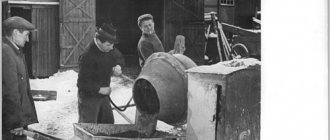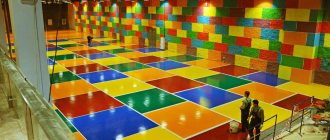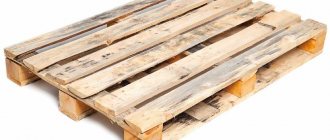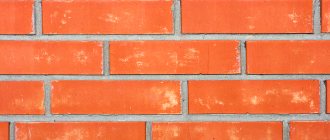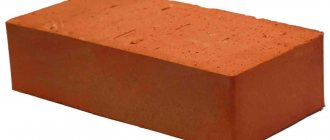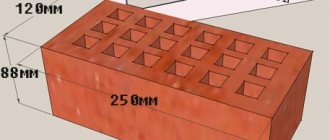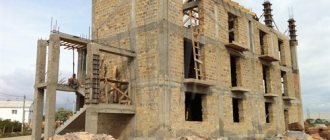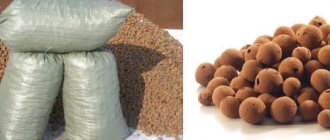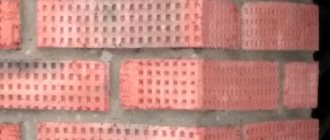Foam concrete, like aerated concrete, belongs to cellular concrete. In addition, their similarity lies in the fact that both of these building materials have a porous structure, which serves as a good heat insulator, but, nevertheless, their manufacturing technology is significantly different from each other and, accordingly, each of them, due to this, acquires its own personal properties.
Foam concrete, unlike aerated concrete, can be made with your own hands.
Features of the material
It would seem that clay as a building material is a thing of the past, but with the development of ecological construction, it has recently begun to be actively used again. The fact is that finely ground clay is a good astringent and preservative.
If you dilute it with water and add a filler to the solution, for example, plant fibers or sawdust, you can get an excellent and environmentally friendly thermal insulation material. For example, such a mixture is often used to fill hollow slag and expanded clay concrete blocks or as insulating plaster.
Also, gypsum, lime or even cement are sometimes added to the mixture, which makes clay concrete more durable. This allows it to be used as a load-bearing material in the construction of environmentally friendly houses.
The volumetric mass of the material depends on the ratio of the ingredients. The optimal figure is considered to be 550-600 kg per cubic meter.
House made from the described material
There is an opinion that such material can rot and is also a fire hazard, since it contains straw or sawdust. However, this is just speculation, since chopped plant stems and sawdust in a clay liquid solution swell and are well enveloped in clay, which not only binds them reliably, but also preserves them.
As for the fire hazard, the filler begins to smolder only when exposed to an open flame, for example, a gas flame, for several minutes. As a result, the fire safety of the material is even higher than that of some more traditional materials used in construction.
Straw for making material
Advantages
The growing popularity of the material is explained by its following advantages:
- Contribute to the formation of a microclimate favorable for humans . Clay is able to absorb and release moisture faster and in a much larger volume than traditional building materials. Moreover, this does not affect the strength of the material.
- Accumulates heat . Thanks to this property, the material can create comfortable living conditions even in conditions of large daily temperature changes.
- Possibility of reuse , for this the material just needs to be soaked in water.
- Ideal for building a house with your own hands . The material does not require the use of construction equipment and expensive equipment. The technology for working with it is accessible even to inexperienced builders.
- Clay protects wood and other organic materials from rotting . If you treat wooden walls with it, they will not be affected by either fungus or insects.
- Clay purifies the air by absorbing pollutants.
- Low price of material . Thanks to this, construction using clay is not only environmentally friendly, but also economical.
Note! When producing lightweight material with a density of less than 500-600 kg per cubic meter, the material must be dried. Otherwise, the straw will remain wet for a long time and will eventually begin to rot.
Masonry made from the material in question
Flaws
Of course, along with its advantages, clay concrete also has some disadvantages:
- The strength is less than 600 kg per cubic meter, as a result of which nails and dowels do not hold in it. Plastering can only be done using reinforcement.
- When the solution dries, significant shrinkage occurs.
Why do you need a foaming agent?
Also, when producing foam concrete, the composition necessarily contains foaming agents. They come in two types: natural and synthetic. The first ones are made from environmentally friendly materials, so the resulting foam blocks have no restrictions on use. If we talk about synthetic foaming agents, they are used mainly to reduce the cost of the resulting product.
When making blocks, ash can also be added. This allows you to reduce cement consumption without losing the strength of the material. However, this leads to a decrease in heat-protective properties.
Preparation of material
Composition and proportions
To prepare durable and “warm” material, the following components are used:
| Components | Quantity per 1 m3 |
| Sawdust and chopped straw | 200 kg |
| Slaked lime | 70 kg |
| Construction gypsum | 30 kg |
| Clay | 300 kg |
| Water | 350 l |
Clay for material
Preparation of the solution
You can prepare the solution in a regular concrete mixer.
The instructions look like this:
- Before you start preparing the solution, you need to prepare the straw fiber. Its length should not exceed the thickness of the material. For example, if the solution will be used to pour into formwork for concrete with a thickness of 20 cm, then the length of the fiber should also be no more than 20 cm.
- Then water is added to the concrete mixer and lime is poured into it. The contents are thoroughly mixed.
- Next, straw fiber for concrete and sawdust is poured.
- After the filler has soaked, gypsum is added.
- Lastly, finely ground clay is gradually added with constant stirring.
Expanded clay
Tips for choosing and using foam blocks
- When choosing foam blocks, you should pay attention to the color of the material, it should be gray (the tone can be lighter or darker) and always uniform. White blocks are of poor quality.
- You should also check the tightness of the foam block cells. The structure of the block should be the same both inside and outside. The cells must be round, not connected to each other. Also, the blocks should not have cracks or chips.
- You should also check the geometry of the block, because if any of the sides are different, this may complicate the process of laying the material.
- If you purchased fresh material, you should not use it until it acquires the necessary strength, and this happens on the 28th day after making foam concrete.
- It is better to lay foam blocks not on ordinary mortar, but on cement-based glue. Thanks to this, much thinner seams between blocks will not become cold bridges.
Mineral fillers
In many ways, the characteristics of the material depend on the filler. Therefore, experts recommend using various mineral porous fillers instead of straw fiber to improve the thermophysical properties.
For example, the following is great for these purposes:
- Foam glass;
- Expanded clay;
- Pumice;
- Expanded perlite;
- Volcanic tuff.
It must be said that the correct ratio of mineral fillers will completely solve the problem of shrinkage.
If we compare clay concrete based on mineral filler with clay fiber concrete, the vapor permeability coefficient of the former is several times higher, which reduces the likelihood of condensation forming in the wall.
Now let's take a closer look at the above types of fillers.
Expanded clay structure
Expanded clay
It is an inexpensive and lightweight aggregate made in the form of granules. Its feature is good strength, despite the fact that the density is 250-800 kg/m3.
Expanded clay is produced by firing low-melting clay at temperatures up to 1200 degrees Celsius. As a result of the release of a gaseous substance inside the granules, the clay swells. As a result, expanded clay has a porous structure that represents frozen foam, but the shell gives the granules high strength.
Foam glass
Foam glass
Foam glass is an artificial material resembling pumice, with a density of 100-700 kg per cubic meter. The process of making it involves swelling ground glass, which is mixed with a small amount of limestone, charcoal or other materials that can release gas when the glass softens.
Expanded perlite
Expanded perlite
Expanded perlite is also made by firing volcanic glassy rocks. During the firing process at a temperature of 1000 degrees Celsius, water evaporates and perlite increases up to 20 times.
The bulk density of perlite is 60 kg per cubic meter, and the thermal conductivity coefficient is 0.045 W/m K.
Volcanic tuff
Volcanic tuff
Volcanic tuff is the name given to rocks formed as a result of the solidification of volcanic eruption products - pumice, ash, etc., which were subsequently cemented and compacted.
Pumice
Pumice
This material is porous volcanic glass, formed during the solidification of medium and acidic lavas, which release gas. The density of pumice is in the range of 500-750 kg per cubic meter.
Advice! The clay solution can be poured into formwork, like ordinary concrete, or made into blocks for building walls. When pouring, the mixture must be compacted.
In the photo - cork chips
When additional insulation is needed
Structural foam blocks are no longer used for thermal insulation purposes. They have greater thermal conductivity and lower vapor permeability. Therefore, buildings constructed from foam blocks of grades d1000-d1200, with high heat transfer, require additional insulation. If we talk about the strength of this material, it is very high. These are the types of foam concrete that are used in multi-story construction. Structurally, porous blocks are not mass-produced, therefore they do not have the characteristics regulated by GOST. The high density of this material allows it to be used to construct buildings that are not limited in number of floors.
Lightweight clay cork concrete
Among organic fillers, in addition to straw and sawdust, cork chips are often used. The advantages of this material include low bulk density. As for the disadvantages, this filler is quite expensive, in addition, the compressive strength of cork is significantly lower than expanded clay.
It must be said that in construction stores you can find dry mixtures that contain the following components:
- Crushed clay;
- Cork chips;
- Straw fiber;
- Small amount of cellulose.
This mixture is most often used as thermal insulation when constructing walls or plaster. Before use, the mixture is diluted in water.
The density of clay cork concrete is 300-450 kg per cubic meter. Thermal conductivity coefficient is 0.07-0.08 W/m K.
Integral part – construction fiber
Another component that is added when making foam concrete is construction fiber. This micro-reinforcement material can increase strength by 25%.
If we take the technical characteristics of a foam block with increased strength, it is used only in the case of a very high load on the walls. Otherwise, it will be sufficient to use blocks with a standard composition.
Rhyme for the word clay concrete
This page contains rhymes with the word adobe
The number of rhymes found is 489.
The emphasis in the word “clay concrete” should be placed on the syllable with the letter N - clay concrete
Found rhymes for the word "clay concrete":
- foam concrete
- asphalt clay concrete
- string concrete
- woodconcrete
- aerated concrete
- reinforced concrete
- pumice concrete
- cinder concrete
- gypsum slag concrete
- wire concrete
- sloping concrete
- ash concrete
- pneumatic concrete
- vibrated concrete
- bone concrete
- gypsum concrete
- silicate concrete
- expanded clay concrete
- asphalt expanded clay concrete
- perlite concrete
- vermiculite concrete
- agloporite concrete
- cement concrete
- soil concrete
- plastic concrete
- asbestos concrete
- rubble concrete
- asphalt concrete
- peat concrete
- tuff concrete
- concrete
- shotcrete
- steel concrete
- tar concrete
- eposlanbeton
- polymer concrete
- shotcrete
- bad manners
- Soveton
- velveton
- reggaeton
- asideton
- asyndeton
- polysyndeton
- token
- ketone
- fluoroketone
- blunderbuss
- skeleton
- peleton
- goatton
- chuleton
- magneton
- cretonne
- acetone
- acetopylacetone
- bromoacetone
- feuilleton
- mini-feuilleton
- feuilleton novel
- tone
- Aten
- loaf
- hyperbaton
- backwater
- Shamaton
- flexatone
- Teuton
- Bedlington
- Arlington
- Remington
- Orpington
- ringtone
- Washington
- Geraldton
- graviton
- oriton
- soliton
- niton
- python
- Kapiton
- rhyton
- baritone
- Khariton
- emiriton
- hangout
- drug den
- triton
- polariton
- paroxiton
- exciton
- multitone
- periphyton
- nematophyton
- chiton
- lactone
- nekton
- rekton
- plankton
- epiplankton
- cryoplankton
- megaloplankton
- potamoplankton
- nanoplankton
- nannoplankton
- zooplankton
- macroplankton
- phytoplankton
- Hamilton
- Anton
- Canton
- centon
- Clinton
- badminton
- bonton
- wonton
- Edmonton
- pontoon
- block pontoon
- spontoon
- gable
- Anantapodoton
- demicoton
- demikoton
- peloton
- different tone
- roton
- croton
- proton
- diproton
- antiproton
- electroton
- anelectroton
- photon
- Kapton
- lepton
- microlepton
- blindton
- peptone
- krypton
- Compton
- cardboard
- plasterboard
- Parton
- Shepparton
- overtone
- Everton
- fork
- underton
- Untherton
- moan
- kingston
- seston
- festoon
- Liviston
- histone
- phlogiston
- piston
- cornet-a-piston
- Ariston
- plaiston
- Neuston
- playston
- Neuston
- Boston
- Waltz-Boston
- lignostone
- Palmerston
- palmerston
- Charleston
- seston
- button
- cotton
- bud
- semitone
- Pluto
- Mouton
- crouton
- Grafton
- allochthon
- autochthon
- autochthon
- milton
- Shackleton
- phaeton
- asyndeton
- Newton
- meganewton
- kilonewton
- He
- comp-lex-on
- anti-AON
- Pharaoh
- swallowtail
- bond
- Gabon
- balabon
- salabon
- relaxed
- Lisbon
- gibbon
- fuck
- asshole
- fuck
- bending
- trombone
- zabobon
- carbon
- bourbon
- Greensbon
- bubo
- cut off
- over there
- flavone
- Devonian
- Levon
- elevon
- ringing
- calling
- chime
- pealing
- auto redial
- asshole
- windbag
- drinker
- pulpit
- rut
- agon
- railway carriage
- saloon car
- free carriage
- aidaravagon
- metro car
- air car
- caravan
- propaganda car
- gondola car
- special car
- corral
- decagon
- enneadakagon
- glucagon
- surge
- pagon
- Harpagon
- tetragon
- ditetragon
- tarragon
- hexagon
- Pentagon
- heptagon
- mahogany
- overtaking
- drive
- customization
- stage
- stegon
- azhgon
- acceleration
- sublimate
- polygon
- heliopolygon
- auto test site
- epigone
- fit
- trine
- parangon
- fire
- snowman
- catch up
- catch up
- honey extractor
- isogon
- makogon
- Pecogon
- stitching
- smologon
- moonshine
- foam
- horse racer
- slobber
- shoulder strap
- run
- thermal run
- cattle drive
- carminative
- logging
- lysogon
- slope
- cattleman
- raftsman
- palace
- anthelmintic
- argon
- jargon
- van
- mini van
- campervan
- drive
- Vodosgon
- distillation
- hijacking
- air hijacking
- anti-theft
- car theft
- pasture
- Don
- celadon
- espadon
- radon
- methadone
- addon
- Armageddon
- pallet
- Euro pallet
- cotyledon
- Meudon
- comedo
- Automedon
- boustrophedon
- chalcedony
- drapizdon
- can
- quirk
- pyrrolidone
- pyramidon
- Cupid
- geridon
- Poseidon
- chaldon
- Cheldon
- doldon
- Andon
- abandonment
- condom
- propaganda
- condom
- London
- Rigodon
- Dodon
- codon
- anticodon
- flat bottom
- Platybelodon
- entelodon
- smilodon
- entelodon
- pteranodon
- iguanodon
- Dimetrodon
- bombardon
- sorry
- Gordon
- setter gordon
- Satter-Gordon
- cordon
- bourdon
- odeon
- accordion
- Leon
- galleon
- chameleon
- Napoleon
- neon
- bandoneon
- peon
- pentacampeon
- preon
- freon
- pantheon
- osteon
- John
- dude
- must
- donjon
- scabbard
- trouble
- princes
- zones
- flowerpot
- lawn
- alazon
- Amazon
- climazon
- pharmazon
- range
- subband
- radio band
- borazon
- gambeson
- meson
- kappamaison
- overalls
- wetsuit
- reason
- season
- TV season
- not a season
- demi-season
- political season
- buffalo
- bison
- prednisone
- garrison
- air garrison
- Reason
- cortisone
- hydrocortisone
- exon
- Robinson
- ozone
- boson
- biozone
- cozon
- blouson
- Jason
- and he
- gram ion
- zwitterion
- gabion
- Albion
- legion
- region
- subregion
- Ministry of Regional Development
- drug region
- euroregion
- agroregion
- gammadion
- stadium
- cycling stadium
- microstadium
- enchiridion
- androstenedione
- chalazion
- division
- aviation hydraulic division
- artillery division
- illusion
- chalazion
- quasiion
- alkyon
- Lyon
- galion
- Ardalion
- Pygmalion
- talion
- helion
- billion
- million
- quintillion
- quadrillion
- trillion
- octillion
- quintillion
- quadragintillion
- septillion
- sextillion
- undecillion
- mion
- fermion
- anion
- carbanion
- dominion
- Agrinion
- amnion
- quaternion
- semiquaternion
- union
- trade union
- trade union
- reunion
- macroion
- peony
- apion
- lampion
- champion
- champion
- vice-champion
- ex-champion
- hypopyon
- entropion
- scorpion
- cancerscorpio
- spy
- spy satellite
- spy plane
- spy ship
- super spy
Add your comments to the rhyming word adobe
Summarize
As you can see, with the same amount of foaming agent, an increase in the mass of Portland cement and sand leads to an increase in the density of foam concrete. The higher the final density of foam concrete is expected, the higher the grain size of the sand used should be.
Although not everyone who uses foam concrete blocks in the construction of buildings makes them themselves. Still, understanding the proportions will help you understand its strength and other characteristics when purchasing a material.
